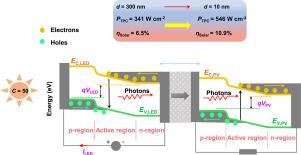Concentrated near-field thermophotonics for efficient solar energy harvesting: Model development, system analysis, and performance optimization
IF 6.3
2区 材料科学
Q2 ENERGY & FUELS
引用次数: 0
Abstract
In recent years, research on near-field thermophotonic systems has predominantly focused on waste heat recovery and electroluminescence cooling, while studies on near-field thermophotonic converters for solar energy harvesting have not been reported. We propose a near-field solar thermophotonic converter (NF-STC) that harnesses the full solar spectrum to generate electricity. Considering fluctuational electrodynamics and nonradiative recombination losses, we developed a self-consistent model to theoretically evaluate the performance of the NF-STC system from far-field to near-field regimes under two scenarios: varying LED temperature and fixed LED temperature. In the case of variable LED temperature, we identify that increasing the solar concentration, decreasing the thickness of the semiconductor material to mitigate the effect of non-radiative recombination, narrowing the vacuum gap spacing, and implementing gold back reflector for photon recycling can significantly bolster the performance of the system. Specifically, when the gap spacing is 10 nm, and the solar concentration factor is 400, we show that the total electrical power density and overall conversion efficiency can reach 8892 mW cm−2 and 22.2%, respectively. Conversely, in the fixed LED temperature scenario, the performance characteristics diverge from those observed in the variable temperature case. The system exhibits superior performance at higher LED temperatures and smaller gap spacing. This work deepens the understanding of thermophotonic converters’ application in solar energy harvesting by considering the interplay of various physical phenomena. It presents a promising pathway for efficient solar thermal power conversion.

用于高效太阳能收集的聚光近场热光子学:模型开发、系统分析和性能优化
近年来,有关近场热光子系统的研究主要集中在余热回收和电致发光冷却方面,而有关用于太阳能收集的近场热光子转换器的研究尚未见报道。我们提出了一种近场太阳能热光子转换器(NF-STC),它能利用整个太阳光谱发电。考虑到波动电动力学和非辐射重组损耗,我们建立了一个自洽模型,从理论上评估了 NF-STC 系统在两种情况下从远场到近场的性能:变化的 LED 温度和固定的 LED 温度。在 LED 温度可变的情况下,我们发现提高太阳光浓度、减小半导体材料厚度以减轻非辐射重组的影响、缩小真空间隙间距以及采用金背向反射器进行光子回收,都能显著提高系统的性能。具体来说,当间隙间距为 10 nm、太阳光集中系数为 400 时,我们发现总功率密度和整体转换效率分别可达到 8892 mW cm-2 和 22.2%。相反,在 LED 温度固定的情况下,其性能特征与在温度可变的情况下观察到的性能特征有所不同。该系统在较高的 LED 温度和较小的间隙间距下表现出卓越的性能。这项研究通过考虑各种物理现象的相互作用,加深了人们对热光子转换器在太阳能收集中的应用的理解。它为高效太阳能热能转换提供了一条前景广阔的途径。
本文章由计算机程序翻译,如有差异,请以英文原文为准。
求助全文
约1分钟内获得全文
求助全文
来源期刊

Solar Energy Materials and Solar Cells
工程技术-材料科学:综合
CiteScore
12.60
自引率
11.60%
发文量
513
审稿时长
47 days
期刊介绍:
Solar Energy Materials & Solar Cells is intended as a vehicle for the dissemination of research results on materials science and technology related to photovoltaic, photothermal and photoelectrochemical solar energy conversion. Materials science is taken in the broadest possible sense and encompasses physics, chemistry, optics, materials fabrication and analysis for all types of materials.
 求助内容:
求助内容: 应助结果提醒方式:
应助结果提醒方式:


